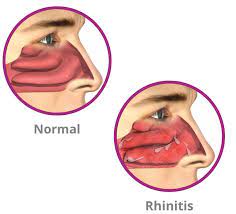Want help to write your Essay or Assignments? Click here
Rhinitis Patient Diagnosis
Richard presented to the healthcare facility with complaints of postnasal drainage, sneezing, rhinorrhea, and nasal congestion. These clinical manifestations are common in patient diagnosed with Rhinitis. Therefore, the Advance practitioner differential diagnoses are correct. Allergic rhinitis is most likely because patient complains of runny nose, sneezing, red itchy watery eyes, sore throat and nasal congestion (Kaliner, 2011).
This is confirmed by allergy test, nasal smear for eosinophils. It is important that the advance practitioner nurse requested for nasal smear as it helps confirm the presence of eosinophils in the nasal secretions. Presence of eosinophils indicates that the patient is diagnosed with allergic rhinitis. Blood test is also important to check for IgE antibodies which will help to confirm the diagnosis of allergic rhinitis (Dains, Baumann, & Scheibel, 2016).
Infectious Rhiniti is suspected because of patient’s signs and symptoms such as sneezing, rhinorrhoea, cough, and congestion. This is ruled out by the laboratory test findings. Non-allergic rhinitis is suspected nasal congestion, sneezing and runny nose. The immunological tests results rules out the likelihood infection (Kaliner, 2011).
Rhinitis medicamentosa is suspected due to presence of nasal congestion. This mainly occurs when the patient uses certain oral medications such as topical decongestants and some oral medications. These medications make the blood vessels to constrict causing nasal congestion. This is not likely because the patient denies use of oral medications and topical decongestants (Kaliner, 2011).
Want help to write your Essay or Assignments? Click here
Nasal speculum is also good as it helps visualize the patient’s nasal turbinate’s and mucosa. Presence of pale and boggy turbinates’ is an indicator of allergic rhiniti. However, I think further diagnostic tests should have been considered. This includes imaging tests such as CT scans to check if the patient has sinusitis, associated structural defects or chronic inflammation. Rhinoscopy should have been conducted as it would help to check for nasal polyps and associated complications (Ball et al., 2015).
References
Ball, J. W., Dains, J. E., Flynn, J. A., Solomon, B. S., & Stewart, R. W. (2015). Seidel’s guide to physical examination (8th ed.). St. Louis, MO: Elsevier Mosby.
Dains, J. E., Baumann, L. C., & Scheibel, P. (2016). Advanced health assessment and clinical
diagnosis in primary care (5th ed.). St. Louis, MO: Elsevier Mosby.
Kaliner, M. (2011). Rhinitis. Philadelphia, Pa.: Saunders.
Want help to write your Essay or Assignments? Click here


